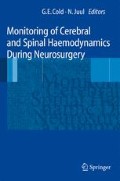Abstract
Intracranial pressure monitoring is based on the premise that the intracranial space is one compartment without pressure differences between brain regions. To what extent the pressure within the subarachnoid space correlates with pressures in other brain regions and whether an increase in pressure within the brain substance is transmitted to the rest of the brain and to the subarachnoid and ventricular cerebrospinal fluid are debated. In this chapter we summarize and discuss four studies dealing with regional subdural pressure gradients during craniotomy. The first study refers to studies of pressure gradients between subdural ICP and pressures within the neuroaxis, including intraventricular pressure and lumbar spinal pressure. The second study refers to subdural pressure gradients within the surgical field in patients with supratentorial tumour, the third study to pressure gradients within the surgical field in patients with infratentorial tumour, and the fourth study to changes in subdural ICP during opening of dura.
Access this chapter
Tax calculation will be finalised at checkout
Purchases are for personal use only
Preview
Unable to display preview. Download preview PDF.
References
Broaddus WC (1989) Differential intracranial pressure recordings in patients with dual ipsilateral monitors. In: Hoff JT, Bentz AL (eds) Intracranial pressure VII. Springer, Berlin
Brock M, Beck J, Markakis E et al (1972) Intracranial pressure gradients associated with experimental cerebral embolism. Stroke 3:123–130
Brock M, Furuse M, Weber R et al (1975) Brain tissue pressure gradients. In: Lundberg N, Ponten U, Brock M (eds) Intracranial pressure II. Springer, Berlin, pp 215–220
Bundgaard H, Cold GE (2000) Studies of regional subdural pressure gradients during craniotomy. Br J Neurosurg 14:229–234
Cairns H (1939) Raised intracranial pressure: hydrocephalic and vascular factors. Br J Surg 27:275–294
Ecker A (1955) Irregular fluctuation of elevated cerebrospinal fluid pressure. Such fluctuations as a measure of dysfunction of cerebrovascular episodes, pseudotumour cerebri, and head injury. Arch Neurol Psychiatry 74:641–649
Furuse M, Brock M, Hasuo M et al (1981) Relationship between brain tissue pressure gradients and cerebral blood flow distribution studied in circumscribed vasogenic cerebral oedema. Neurochirurgia (Stuttg) 24:10–14
Haines DE, Harkey HL, Mefty O (1993) The ‘subdural’ space: a new look at an outdated concept. Neurosurgery 32:111–120
Iannotti F, Hoff JT, Schielke GP (1985). Brain tissue pressure in focal cerebral ischemia. J Neurosurg 62:83–89
Johnston IH, Rowan JO (1974) Raised intracranial pressure and cerebral blood flow. 4. Intracranial pressure gradients and regional cerebral blood flow. J Neurol Neurosurg Psychiatry 37:585–592
Kaufmann GE, Clark K 1970) Continuous simultaneous monitoring of intraventricular and cervical subarachnoid cerebrospinal fluid pressure to indicate development of cerebral or tonsillar herniation. J Neurosurg 33:145–150
Langfitt TW, Elliott FA (1967) Pain in the back and legs caused by cervical spinal cord compression. JAMA 200:382–5
Langfitt TW, Weinstein JD, Kassell NE et al (1964a) Transmission of increased intracranial pressure I. Within the craniospinal axis. J Neurosurg 21:989–997
Langfitt TW, Weinstein JD, Kassell NF et al (1964b) Transmission of increased intracranial pressure II. Within the supratentorial space. J Neurosurg 21:998–1005
Leech PJ (1974) Intracranial pressure-volume relationships during experimental brain compression in primates. J Neurol Neurosurg Psychiatry 37:1093–1098
Lundberg N (1960) Continuous recording and control of ventricular fluid pressure in neurosurgical practice. Acta Psychiat Scand 36(suppl 149):1–193
Miller JD, Garibi J (1972) Intracranial volume/pressure relationships during continuous monitoring of ventricular fluid pressure. In: Brock M, Dietz H (eds) Intracranial pressure. Experimental and clinical aspects. Springer, Berlin, pp 270–274
Miller JD, Leech PJ, Pickard JD (1975) Volume pressure response in various experimental and clinical conditions. In: Lundberg N, Ponten U, Brock M (eds) Intracranial pressure II. Springer, Berlin, pp 97–100
Park TS, Cail WS, Broaddus et al (1989) Lumboperitoneal shunt combined with myelotomy for treatment of syrengohydromyelia. J Neurosurg 70:721–727
Piek J, Plewe P, Bock WJ (1988) Intrahemispheric gradients of brain tissue pressure in patients with brain tumours. Acta Neurochir (Wien) 93:129–132
Reulen HJ, Kreysch HG (1973) Measurement of brain tissue pressure in cold induced cerebral oedema. Acta Neurochir (Wien) 29:29–40
Reulen HJ, Graham R, Spatz M et al (1977) Role of pressure gradients and bulk flow in dynamics of vasogenic brain edema. J Neurosurg 46:24–35
Rosner M (1996) Techniques for intracranial pressure monitoring. In: Tindall G, Cooper P, Borrow D (eds) The practice of neurosurgery. Williams and Wilkins, Baltimore, pp 95–119
Smyth GE, Henderson WR (1938) Observations on the cerebrospinal fluid pressure on simultaneous ventricular and lumbar punctures. J Neurol Neurosurg Psychiatry 1:226–237
Soni SR (1974) Continuous measurement of differential CSF pressures across the tentorium. J Neurol Neurosurg Psychiatry 37:1283–1284
Symon L, Pasztor E, Branston NM (1974) Effect of supratentorial space-occupying lesions on regional intracranial pressure and local cerebral blood flow: an experimental study in baboons. J Neurol Neurosurg Psychiatry 37:617–626
Takizawa H, Gabra Sanders T et al (1986) Analysis of changes in intracranial pressure and pressure-volume index at different locations in the craniospinal axis during supratentorial epidural balloon inflation. Neurosurgery 19:1–8
Weaver DD, Winn HR, Jane JA (1982) Differential intracranial pressure in patients with unilateral mass lesions. J Neurosurg 56:660–665
Weinstein JD, Langfitt TW, Bruno L et al (1968) Experimental study of patterns of brain distortion and ischemia produced by an intracranial mass. J Neurosurg 28:513–521
Wolfla CE, Luerssen TG, Bowman RM (1996) Brain tissue pressure gradients created by expanding frontal epidural mass lesion. J Neurosurg 84:642–647
Yano M, Ikeda Y, Kobayashi S (1987) Intracranial pressure in head-injured patients with various intracranial lesions is identical throughout the supratentorial intracranial compartment. Neurosurgery 21:688–692
Author information
Authors and Affiliations
Editor information
Editors and Affiliations
Rights and permissions
Copyright information
© 2008 Springer-Verlag Berlin Heidelberg
About this chapter
Cite this chapter
Bundgaard, H., Cold, G. (2008). Studies of Regional Subdural Pressure Gradients During Craniotomy. In: Cold, G., Juul, N. (eds) Monitoring of Cerebral and Spinal Haemodynamics During Neurosurgery. Springer, Berlin, Heidelberg. https://doi.org/10.1007/978-3-540-77873-8_5
Download citation
DOI: https://doi.org/10.1007/978-3-540-77873-8_5
Publisher Name: Springer, Berlin, Heidelberg
Print ISBN: 978-3-540-77872-1
Online ISBN: 978-3-540-77873-8
eBook Packages: MedicineMedicine (R0)

